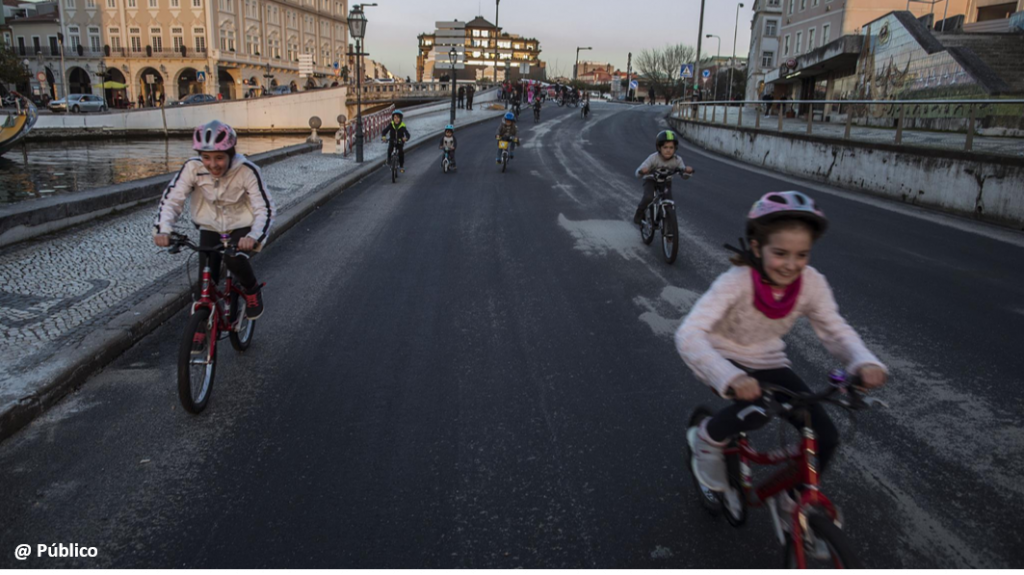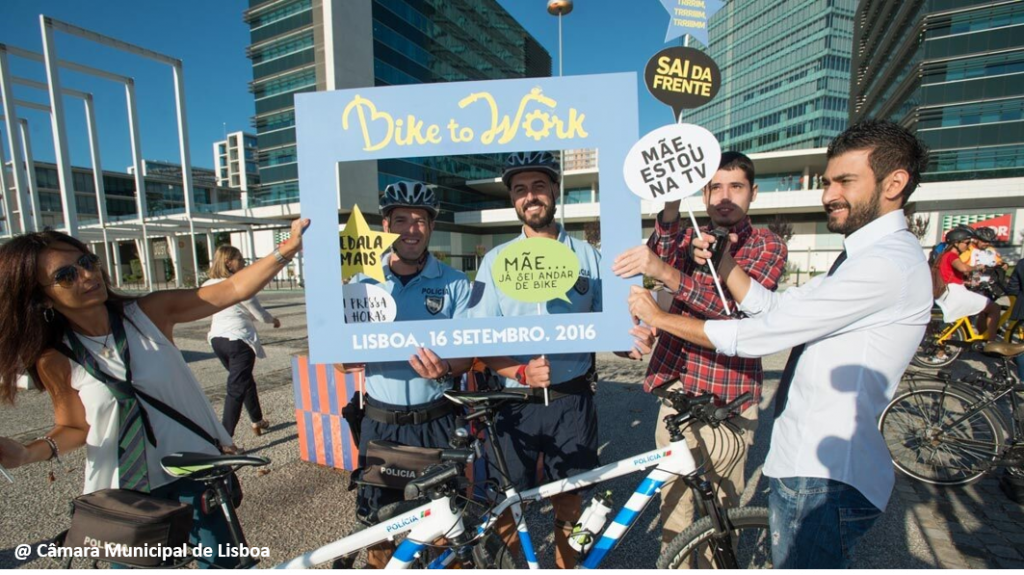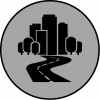
1. Presentation
Bicycle promotional events directed at a group, community or entire city, increasing awareness on cycling for the overall public and attracting new users. They may have many shapes, from small to big, generally combining a mix of activities, entertainment, information and education about bicycles and cycling, providing a fun way to get people interested in cycling and to give them a hands-on experience with bikes and bicycling.
2. Objectives
- Providing hands-on experience with cycling, in order to attract new and novice cyclists and get them interested in cycling;
- Integrating entertainment with bicycle education;
- Raising the general public’s awareness to cycling;
- Encouraging the use of the bicycle as a transport mode.
3. Measure’s importance
A bicycle event enables reaching a large number of people and a variety of groups at the one time bringing various members of the cycling community together and attracting new ones bringing various members of the cycling community together and attracting new ones. It is an excellent promotional tool as it provides cycling hands-on experience. By experiencing how useful and fun cycling is, people will be encouraged to consider using it as a transport mode. Furthermore, it reinforces the city’s commitment with the bicycle, fostering its social normalization.
1. Good Practices
– Bike events and guided tours allow people to discover cycling in a positive environment. Local residents may be invited to participate in field trips to define cycling needs and opportunities. The event must be well divulged, since its success depends on the number of participants.
– The scale of the event depends on the number of resources available, but the site must be easily accessed by public transportation and bicycle. Streets and public spaces are a good site to democratize access to them.
– In the case of starter cycling cities, it is important to appeal to those who do not use bicycle, instead of those who are already convinced.
– In the case of mass events, special attention must be given to provide a positive experience for all, given the elevated concentration of different people.
– The event must not be a single initiative, having instead a regular frequency (at least annually), to improve and observe the development of interest and participation levels throughout time.
– It is also advantageous to use big events with the potential to increase visibility and media attention to the theme (e.g.: music festivals, sports events, sustainability fairs).
– In a context where the bicycle still is not valued, the event would ideally be free.
– Initiatives and post-event activities should be conducted to reinforce and maintain recent behaviour changes in travels.
– Monitor citizens’ adaptation to changes and reformulate measures to respond to users’ needs, without compromising sustainable ideals (See Management, monitoring and maintenance).
– Explain the principles behind the measures taken so that their need and functioning are clear (See Information).
2. Actions
 | Bicycle festivals Festivals – small or big scale – should be fun and participative events, that connect with potential cyclists, integrating entertainment and fun with information and education. Festivals can include live music, bicycle decoration and personalization, equipment moved by bicycle (as in a music system or a blender), short lessons on bicycle use, groups tours with a focus on urban space and the specificities of the local landscape, bicycle parades, obstacle courses for children (or adults) to learn and practice bicycle skills, games, such as “bike-polo”, races adapted to the characteristics of each site, like the “Subida à Glória” (Climb to Gloria) in Lisbon and amateur races like Criterium Bycicle Race, conducted in ities all over the world, bicycle tests, quizzes on bicycles (potentially with a bicycle as a prize), etc. Learn more: Festival Bike Portugal |
 | Group bicycle tours Organizing group tours, at night or in the weekends, to allow for people to experiment cycling in the city in a group context, which is particularly important due to the social influence and greater safety sensation. Note: It is necessary to find volunteers or designate teams to organize the tours. Learn More: “De Bicla 1 domingo por mês" initiative, promoted by the Portuguese Cicloturism and Bicycle Users Federation (Federação Portuguesa de Cicloturismo e Utilizadores de Bicicleta - FPCUB). |
 | Bicycle Day/Week Public events and initiatives to improve the environment, public health and life quality, through promoting active mobility, sustainable urban transport and including the bicycle in development policies and programmes on an international, national and subnational level. In beginner cities, it is very advantageous to integrate broader events (national or international level), for instance during “European Mobility Week”, to reinforce the initial city efforts and sensitize its citizens to participate in a bigger movement. For greater effectiveness, these programmes should integrate at least one permanent measure, for instance the inauguration of a cycle path, the creation of a shared street, where automobile traffic has been strongly reduced or eliminated, new parking spaces for bicycles, the inauguration of one or more new bike sharing stations, etc. Learn More: Semana Europeia da Mobilidade; Dia da Bicicleta da ONU / 3 de junho (criado em 2018). |
 | Bike to Work/University/Stadium Campaigns “Bike to work/university” day/week/month is a well-known and disseminated campaign, or event. Usually, it includes challenges and incentives to make people travel by bicycle to work or university more frequently, or to try and travel by bike for the first time. It can include provision of breakfast, contests, useful tokens, bicycle activities and other incentives. Another similar and impactful action is promoting cycling to big events, like festivals and stadiums, which attract large crowds in a social and fun environment. Note: It is necessary to designate some employees to plan, organize and manage the programme; in some cases, it can be the organization itself to provide the bicycles. Learn more: Bike commuter challenge; European project Bike2Work promoted by the ECF (European Cyclists' Federation); Healthy Stadia. Similar initiatives are beginning to be promoted in the access to music festivals. |
 | Bicycle test events It is generally a one-day event when people can test a variety of bicycles. Bicycle makers can be invited to bring different models and a small testing course is assembled so people can experiment them. Depending on the level of cycling in the city, the focus can be on potential bicycle users is general, in the needs of a specific target group (like elderly people, disabled people, families with children), in a segment of the urban mobility system (like cycle logistics for traders, supermarkets and delivery companies) or in the introduction of the cargo bicycle in urban centres and neighbourhoods with greater population density or congestion. The practical experience of a bicycle test event helps people find the most suitable bicycle for themselves and thus create a long-lasting enthusiasm for the bicycle. Learn More: “ExtraEnergy showrooms”, whose activities are focused on independent information, promotion and testing small size electric vehicles around the world. |
 | Exhibitions It consists on the exhibition of information on bicycle use in the city during a well-defined period of time. It can be based on posters or placards, reports, charts, digital tools and videos. It can function autonomously or with a benefactor. It is important to carefully think about where to located the exposition, eventually in more than one place, so that it is accessible to multiple people. Learn More: “Cycle Revolution”, exhibit at the Design Museum in London; Bicycle Architecture Biennale (BAB). |
 | Temporary Cycling Streets (See Temporary Cycling Streets) |

The “OccupáRua” was an initiative that took place in Aveiro (Portugal) and was organized on a social networks, mobilizing dozens of people to occupy a newly paved street before its reopening to traffic. The participants, mostly by bicycle, expressed the hope that the spontaneous initiative could inspire regular initiatives.
1. Impacts
 | Mobility system efficiency Bicycle events can have some impact on the increase of the bicycle’s modal share, thus promoting less traffic and more efficiency in the mobility system. Continued success in bicycle events will encourage some people to shift to cycling as a mode of transport. |
 | Livable streets Bicycle events bring people to the street to experiment cycling and its new way of connecting to the city. It promotes, in a punctual or continued fashion, livelier streets. |
 | Protection of the environment As a result of events that aim at increasing bicycle use, the local environment can be improved. |
 | Inclusion, equity and accessibility By being accessible to all and promoting the social acceptability of the bicycle, bicycle events promote greater social equity. However, it is always important to proactively attend the specificities of more vulnerable groups (disabled people, economically struggling people, women, children, young people, elderly, minorities). |
 | Safety and comfort Depending on the focus of events, these may include the increase in awareness to reducing road danger and increasing cycling capacity. |
 | Economic value Bicycle events contribute to stimulate the economy surrounding the bicycle. |
 | Awareness and acceptability When reaching a large number of people and variety of groups, bicycle events are essential to sensitize towards the bicycle and reduce resistance to it. |
Legend:
| Very positive | Positive | Neutral | Negative | Very negative |
2. Barriers
 | Legal The legal framing must be taken into account when developing bicycle events, especially if they occur in public spaces. |
 | Finance The event can be demanding in terms of material and human resources, but ideally it should be free to be accessible by all. Charging participants may help recover some of the costs, in beginner cities, where the bicycle is not yet valued, the cost barrier may be enough to stop people from participating. The scale of the event depends on the available resources and from the contribution of sponsors and other benefactors. |
 | Governance Organizing such an event may be very arduous and demand a lot of labour. The responsibility usually resides in a local authority, but it can articulate the local, national and European/international level. It may involve a large array of partners: local bicycle organizations, manufacturers, bicycle stores, public transportation agencies (connecting bicycles and public transportation), health organizations, environmental and other community groups, schools, local businesses, companies with cycle logistic means, media, local celebrities (politicians, media personalities, sports figures), catering, entertainment suppliers. |
 | Political acceptability In beginner cities, where the bicycle is under- valued, it might be difficult to convince political authorities to place resources in bicycle events. |
 | Public acceptability Bicycle events must be conducted when there is a certain level of cycling infrastructure in the city to have a positive public acceptance and continuity in terms of impacts. |
 | Technical feasibility The success of bicycle events usually dependent on the weather, unless they occur in closed facilities. A wide range of bicycle sizes must be available, as well as attendants or volunteers with experience to make small adjustments (seat height, handlebar, etc.) to assure the participants leave the event with the sensation that riding a bicycle is comfortable, fun and something they would imagine doing more frequently. |
Legend:
| No barrier | Minimum barrier | Moderate barrier | Significant barrier |
3. Budget
| Area | Measure | Unit | Cost | Implementation year |
| Bragança, Bragança (Portugal) | Promotion event for sustainable tourism (MOVELETUR) | 9 vehicles and 91 electric bikes; installing 25 charging posts; development of a monitoring platform for electric vehicles and an exclusive area for vehicle reservation; workshops; lectures; test-drive for electric vehicles (cars and bicycles), promotion initiatives for sustainable tourism and valuing historical and cultural heritage in participating regions | 30 600,00 €* | 2019 |
| Donostia, San Sebastian (Spain) | Promotion campaign for using bicycles while shopping | 170 bicycles | 18 700,00 € | 2009 |
| Bicycle transportation | 1 620,00 € | |||
| Management, disseminating information and other activities | 3 550,00 € | |||
| Newspaper announcements | 1 860,00 € | |||
| Posters, adhesives and stationary items | 1 550,00 € |
* The total budget must have been increased beyond the publicized value, or the cost is shared and only part of it was mentioned because 20 electric mountain bikes and 3 all-terrain electric vehicles were reported to cost 32 434,00€.
Case study 1: Bike to Work Day, Lisbon (Portugal)

“Bike to Work” campaigns are a recurrent initiative around the world to motivate employees to travel by bicycle to work by using some sort of incentive or competition. They might be national, regional or local campaigns, which is the present case. In Lisbon, the “Bike to Work” initiative was conducted in the scope of the European Car Free Day, focusing on City Hall employees and counting on the organization of Lisboa e-nova, a municipal company, and the support of the Portuguese Cicloturism and Bicycle Users Federation (Federação Portuguesa de Cicloturismo e Utilizadores de Bicicleta – FPCUB), Lisboa e-nova and the Portuguese Environment Agency (Agência Portuguesa do Ambiente – APA). The adherent employees received a bag with a T-Shirt, a water canteen, a bicycle lock and a discount coupon for the acquisition of materials of reparations on a bicycle store. There was also a contest conducted regarding sentences allusive to the event, which presents the winner with a bicycle.
Learn More: https://www.fpcub.pt/2011/10/de-bicicleta-para-o-trabalho
Impact:
 | Mobility system efficiency It is expected that “Bike to Work” campaigns promote more travels to the workplace by bicycle, contributing to reduce car traffic. |
 | Livable streets No impacts. |
 | Protection of the environment A successful campaign will increase the use levels of the bicycle and reduce motorized travels, improving the environment. |
 | Inclusion, equity and accessibility No impacts. |
 | Safety and comfort No impacts. |
 | Economic value No impacts. |
 | Awareness and acceptability The campaign promotes a greater awareness and reduces resistances to the bicycle, especially because it has the support of the employer, enabling a contagion effect. |
Case study 2: E-bike testing for senior citizens, Graz (Austria)
Graz is a climber city, with a bicycle modal share of, approximately 14,5% and a comprehensive strategy to promote non-motorized mobility by investing in cycling infrastructure and informational campaigns. In the context of the European Project Active Access, supported by the Graz’ Traffic Planning Department, a pedelec test (acronym for Pedal Electric Cycle) was conducted in the city, in August of 2010. 20 residents who rarely used bicycles for their daily travels, with ages between 45 and 70, had the opportunity to experience the benefits of a pedelec in their daily life for a week. The test aimed to reduce scepticism about electric mobility and push people to be more active, even in a more advanced age.
Learn More: http://www.eltis.org/discover/case-studies/testing-e-bikes-senior-citizens-graz-austria; http://www.active-access.eu
Impact:
 | Mobility system efficiency During the testing month, the 20 participants pedalled approximately 1500 km with their pedelecs (each person had a bicycle for a week). About half of the 1500 km corresponded to a trip that would otherwise been made by car. The action radius increased from a 1,4 km to 3,3 km. Therefore, the testing phase showed that the use of pedelecs could encourage a modal shift from the car to a sustainable mobility. The participants that still work tend to use pedelecs to reach their workplace. |
 | Livable streets No data. |
 | Protection of the environment A modal shift from motorized vehicles to pedelecs would contribute to substantially improve the environment. |
 | Inclusion, equity and accessibility Senior citizens or middle age people enjoy pedelecs because they increase their locomotion radius. The pedelecs are also advisable for people with reduced mobility, which enjoy physical activity and independence. They promote inclusion, equity and accessibility. However, their cost is a barrier for this objective. |
 | Safety and comfort The additional potency of the electric activation system substantially contributes to overcome steep slopes, increasing safety and comfort. |
 | Economic value The acquisition cost for pedelecs are considered a barrier. |
 | Awareness and acceptability In the beginning of the initiative, many of the participants were sceptic towards pedelecs. After the test, the participants changed their opinion, overcoming most of their doubts and scepticism. The participants were also well received by their families and friends. Overall, pedelecs have a good image. Yet, the target-group argued they were in good shape for a conventional bike, with no need for the additional energy. The image of pedelecs for people not in enough of a good shape for ordinary bicycles has to change. Most participants would picture themselves in a pedelec now. |
Case study 3: KAA Gent – Healthy stadia (Belgium)

The programme “Healthy Stadia” (healthy stadiums) has been working with several European sporting clubs to promote cycling and walking to stadiums. One of these clubs, the KAA Gent, with a stadium with the capacity for 20.000 people, assumed a real commitment with promoting active mobility for their fans trips to the stadium. They conducted “Cycling Buffalo” campaign focusing on cycling, but also promoted walking, public transportation and car pooling
Learn more: https://healthystadia.eu/new-active-travel-case-study-developed-with-kaa-gent-belgium/
Impact:
 | Mobility system efficiency During the testing month, the 20 participants pedalled approximately 1500 km with their pedelecs (each person had a bicycle for a week). About half of the 1500 km corresponded to a trip that would otherwise been made by car. The action radius increased from a 1,4 km to 3,3 km. Therefore, the testing phase showed that the use of pedelecs could encourage a modal shift from the car to a sustainable mobility. The participants that still work tend to use pedelecs to reach their workplace. |
 | Livable streets No data. |
 | Protection of the environment A modal shift from motorized vehicles to pedelecs would contribute to substantially improve the environment. |
 | Inclusion, equity and accessibility Senior citizens or middle age people enjoy pedelecs because they increase their locomotion radius. The pedelecs are also advisable for people with reduced mobility, which enjoy physical activity and independence. They promote inclusion, equity and accessibility. However, their cost is a barrier for this objective. |
 | Safety and comfort The additional potency of the electric activation system substantially contributes to overcome steep slopes, increasing safety and comfort. |
 | Economic value The acquisition cost for pedelecs are considered a barrier. |
 | Awareness and acceptability In the beginning of the initiative, many of the participants were sceptic towards pedelecs. After the test, the participants changed their opinion, overcoming most of their doubts and scepticism. The participants were also well received by their families and friends. Overall, pedelecs have a good image. Yet, the target-group argued they were in good shape for a conventional bike, with no need for the additional energy. The image of pedelecs for people not in enough of a good shape for ordinary bicycles has to change. Most participants would picture themselves in a pedelec now. |
Legend:
| Very positive | Positive | Neutral | Negative | Very negative |
Bowles, H.R., Rissel, C., Bauman, A.E. (2006). Mass cycling events: Who participates and is their post-event behaviour influenced by participation? International Journal of Behavioral Nutrition and Physical Activity. Act 3, 39. doi:10.1186/1479-5868-3-39.
Gómez, L.F., Sarmiento, O.L., Lucumí, D.I., Espinosa, G., Forero, R., Bauman, A. (2005). Prevalence and Factors Associated with Walking and Bicycling for Transport Among Young Adults in Two Low-Income Localities of Bogotá, Colombia. Journal of Physical Activity and Health. 2(4): 445–459. Accessed 3 July 2019. Available at: https://doi.org/10.1123/jpah.2.4.445
Horton, D., Salkeld, A. (2006). Bike film festivals: Taking a cultural approach to cycling promotion in the UK. World Transport Policy and Planning. 12, 36–44.
Konsult Knowledgebase on Sustainable Urban Land use and Transport. (2014). Promotional Activities. Accessed 2 July 2019. Available at: http://www.konsult.leeds.ac.uk/pg/55/
PRESTO. Promoting Cycling for Everyone as a Daily Transport Mode (2010a). PRESTO Cycling Policy Guide General Framework. Accessed 24 July 2019. Available at: https://www.polisnetwork.eu/uploads/Modules/PublicDocuments/presto_cycling-policy-guide-general-framework_english.pdf
PRESTO. Promoting Cycling for Everyone as a Daily Transport Mode (2010b). Bike Events and Festivals. 25 PRESTO Implementation Fact Sheets. Accessed 2 July 2019. Available at: https://ec.europa.eu/energy/intelligent/projects/sites/iee-projects/files/projects/documents/presto_fact_sheet_bike_events_and_festivals.pdf
PRESTO. Promoting Cycling for Everyone as a Daily Transport Mode (2010c). Bike Testing Events. 25 PRESTO Implementation Fact Sheets. Accessed 2 July 2019. Available at: https://ec.europa.eu/energy/intelligent/projects/sites/iee-projects/files/projects/documents/presto_fact_sheet_bike_testing_events_en.pdf
Rosas-Satizábal, D. & Rodriguez-Valencia, A. (2018). Factors and policies explaining the emergence of the bicycle commuter in Bogotá. Case Studies on Transport Policy. Accessed 2 July 2019. Available at: https://doi.org/10.1016/j.cstp.2018.12.007
